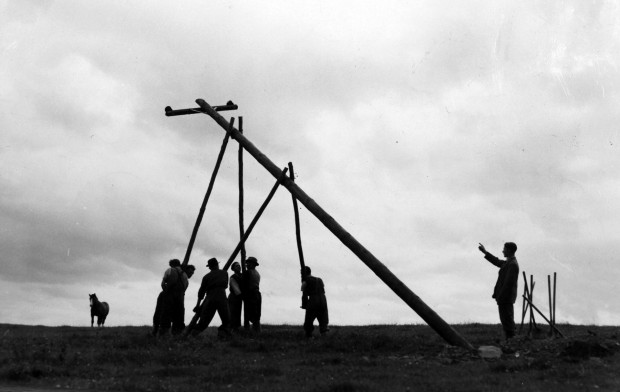3 February 2018
Rural Broadband: A lesson from the past for a digital age

Pole rising during the Rural Electrification scheme (Photo: ESB Archives)
No one can deny now that broadband is a critical national infrastructure. Like the water in the pipes or the tar on the roads, the country would grind to a halt without it.
News broke early this week that Eir were pulling out of the tendering process for the National Broadband Plan. This followed the earlier withdrawal of Siro, who cited that the project was not financially viable after Eir was allowed scoop up 300,000 homes, separate to the process.
This leaves 540,000 homes at the mercies of a tendering process that has a sole applicant. The ghosts of 1999 and the omnishambles of the Telecom Éireann privatisation haunt us still. Not only were those small private investors, so eagerly encouraged to buy in by the Government of the day, hit by a stock market bubble, the crucial tool to provide the critical infrastructure of the burgeoning digital age was neutered, some would say dismantled.
As someone from the South East, rural Carlow more specifically, I’m minded to think of the rural electrification project. The spread of the national grid was always of interest to me. I remember distinctly primary school teachers telling me of how Carlow was the first town to have electric street lighting, switched on by Charles Stewart Parnell in 1891. To a nerdy eight year old, this was a huge badge of honour.
The rural electrification began in 1946 under de Valera’s government. The process ran mainly until 1965 and by 1975, 99% of homes were hooked up to the grid, up from 33% at its inception.
This was an incredibly labour-intensive process that involved canvassing every home that was to be hooked up to ‘the light’ and subsequent follow up visits to explain the whole process. It was also a pleasantly quaint sounding project with the country divided up in nearly 800 parcels, typically along parish lines. There would be a switching on ceremony in the local hall where the lights in the hall and the street lights would all be switched on before the community’s eyes. Though fairly typically for the Ireland of the day, the opening verses of the Gospel of St John was often quoted ‘…and the light shineth in the darkness and the darkness hath not overcome it …’.
The government did all this because it saw electrification as a way of reducing rural isolation and boosting economic activity. Electric milking parlours were just one massive boost to the agricultural community. The night was pushed back and street lights illuminated the way home where before there was little desire to venture out after dark.
The process may have taken 30 years but you could see progress being made, as lines were laid and parishes hooked up, one by one. Little specks of light growing to cover Ireland in islands of light.
1999 was the cusp of the digital age in which we now live. Amazon sold its first book in 1995. Google was established in late 1998. Facebook wouldn’t emerge for another five years. The old 56k dial up internet was what we had and, for all its faults, it opened up a new world. Some had much faster ISDN connections that seemed like warp speed back then but for most, these were prohibitively expensive and we had to make due with browsing what passed for the web until your mother had to use the phone. So many homes do not even have a landline now.
This was the single worst time to sell off a state-owned telecommunications firm.
No one can deny now that broadband is a critical national infrastructure. Like the water in the pipes or the tar on the roads, the country would grind to a halt without it. Understandably, the focus turned first to the cities. Bertie’s Digital Docklands and the IFSC were brought into the 21st century. It made sense to build a global capital with the telecommunications to supply global business. However, that’s where it stopped.
When I say I’m from rural Carlow, that’s debateable. My homeplace is about three miles from the edge of Carlow town. My parents to this day do not have broadband. Three miles is beyond the capability of Irish broadband infrastructure it would appear.
Rural broadband has become the baton passed between Communications Ministers for the last ten years. Eamon Ryan said we’d have it by 2012, Pat Rabbitte extending the deadline a bit (2016), Alex White extended it a bit further (2018) and Denis Naughten is but the latest to tell us to hold on just a little bit longer. You can’t rush these things.
Country folk are good at waiting. Most of us have been waiting all our lives for a trip to Croker for an All-Ireland, most of us would have to wait longer than that. We waited 30 years for rural electrification. Is it too much to ask that the Government recognise the need for good, high quality broadband, a tool to reduce rural isolation and boost economic activity and step in to provide it just a little bit sooner?
Follow us on Facebook
An Phoblacht on Twitter
Uncomfortable Conversations

An initiative for dialogue
for reconciliation
— — — — — — —
Contributions from key figures in the churches, academia and wider civic society as well as senior republican figures





